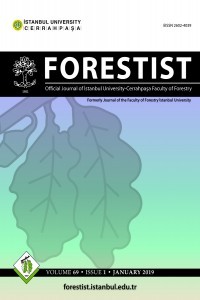Yarı kurak koşullarda bitki grubu büyüklüğünün bazı toprak kimyası parametrelerine etkisi
Besin zengini alanlar, bitki grubu büyüklüğü, İç Anadolu, toprak besin maddeleri, toprak kimyası
Effect of vegetation patch size on selected chemical properties of soils under semiarid climate conditions
Central Anatolia, fertility island, patch size, soil chemistry, soil nutrients,
___
- Aguiar, M.R., Sala, O.E., 1994. Competition, facilitation, seed distribution and the origin of patches in a Patagonian steppe. Oikos, 70, 26-34. Aguiar, M.R., Sala, O.E., 1999. Patch structure, dynamics and implications for the functioning of arid ecosystems. Trends in Ecology and Evolution 14(7): 273-277. APHA, AWWA, WPCF., 1975. Standard Methods for the Examination of Water and Wastewater. 14th edition, Washington, DC. Boer, M., Puigdefábregas, J., 2005. Effects of spatially structured vegetation patterns on hillslope erosion in a semiarid Mediterranean environment: a simulation study. Earth Surface Processes and Land Forms 30: 149-167. Cerdán, M., Sánchez-Sánchez, A., Jordá, J.D., Amat, B., Cortina, J., Ruiz-Vicedo, N., El-Khattabi, M., 2016. Characterization of water dissolved organic matter under woody vegetation patches in semi-arid Mediterranean soils. Science of the Total Environment 553: 340-348. Cross, A.F., Schlesinger, W.H., 1999. Plant regulation of soil nutrient distribution in the northern Chihuahuan Desert. Plant Ecolology 145: 11-25. Erickson, H.E., Soto, P., Johnson, D.W., Roath, B., Hunsaker, C., 2005. Effects of vegetation patches on soil nutrient pools and fluxes within a mixed-conifer forest. Forest Science 51(3): 211-220. Fan, J.W., Du, Y.L., Wang, B.R., Turner, N.C., Wang, T., Abbott, L.K., Stefanova, K., Siddique, K.H.M., Li, F.M., 2016. Forage yield, soil water depletion, shoot nitrogen and phosphorus uptake and concentration, of young and old stands of alfalfa in response to nitrogen and phosphorus fertilisation in a semiarid environment. Field Crops Research 198: 247-257. Fenn, M.E., Perea-Estrada, V.M., de Bauer, L.I., Perez-Suarez, M., Parker, D.R., Cetina-Alcala, V.M., 2006. Nutrient status and plant growth effects of forest soils in the Basin of Mexico. Environmental Pollution 140: 187-199. Firmansyah, I., Spiller M., de Ruijter, F.J., Carjens, G.J., Zeeman, G., 2017. Assessment of nitrogen and phosphorus flows in agricultural and urban systems in a small island under limited data availability. Science of the Total Environment 574: 1521-1532. Fraser, L.H., & Carlyle, C.N., 2011. Is spotted knapweed (Centaurea stoebe L.) patch size related to the effect on soil and vegetation properties? Plant Ecology 212: 975-983. Gökbulak, F., 2013. Vegetation Analyses in Rangelands. Istanbul University publication no: 5151, Faculty of Forestry publication no: 503. Yazın Basın Matbaacılık TRZ. Tic. Ltd. Şti: Istanbul-Turkey. Gülçur, F., 1974. Toprağın fiziksel ve kimyasal analiz metodları. İstanbul Üniversitesi Orman Fakültesi Yayınları, İ.Ü. Yayın No: 1970, OF Yayın No: 201, Kutulmuş Matbaası, İstanbul (In Turkish). IBM, 2012. IBM Corp. Released IBM SPSS statistics for Windows, version 21.0. Armonk: IBM Corp. Lequy, E., Calvaruso, C., Conil, S., Turpault, M.P., 2014. Atmospheric particulate deposition in temperate deciduous forest ecosystems: Interactions with the canopy and nutrient inputs in two beech stands of Northeastern France. Science of the Total Environment 48: 206-215. Li, J., Guo, Q., Zhang, J., Korpelainen, H., Li, C., 2016. Effects of nitrogen and phosphorus supply on growth and physiological traits of two Larix species. Environmental and Experimental Botany 130: 206-215. Maestre, F.T., Cortina, J., 2002. Spatial patterns of surface soil properties and vegetation in a Mediterranean semi-arid steppe. Plant and Soil 241: 279-291. Maestre, F.T., Escudero, A., 2009. Is the patch size distribution of vegetation a suitable indicator of desertification processes? Ecology 90(7): 1729-1735. Muvengwi, J., Ndagurwa, H.G.T., Nyenda, T., 2015. Enhanced soil nutrient concentrations beneath-canopy of savanna trees infected by mistletoes in a southern African savanna. Journal of Arid Environments 116: 25-28. Puigdefábregas, J., 2005. The role of vegetation patterns in structuring runoff and sediment fluxes in drylands. Earth Surface Processes and Landforms 30: 133-147. Ridolfi, L., Laio, F., D’Odorico, P., 2008. Fertility island formation and evolution in dryland ecosystems. Ecology and Society 13(1): 5. Online document. Available from: http://www.ecologyandsociety.org/vol13/iss1/art5/. Accessed 13 October 2017. Roundy, B.A, Call, C.A., 1988. Revegetation of arid and semiarid rangelands, in: P.T. Tueller (ed.), Vegetation Science Applications for Rangeland Analysis and Management. Kluwer Academic Publishers, Dordrecht, Boston. Schade, J.D, Sponseller, R., Collins, S.L., Stiles, A., 2003. The influence of Prosopis canopies on understorey vegetation: Effects of landscape position. Journal of Vegetation Science 14: 743-750. Schade, J.D., Hobbie, S.E., 2005. Spatial and temporal variation in islands of fertility in the Sonoran Desert. Biogeochemistry 73: 541-553. Uchida, R., 2000. Essential Nutrients for Plant Growth: Nutrient Functions and Deficiency Symptoms. In: Silva A.J., and Uchida, R. (Eds.), Plant Nutrient Management in Hawaii’s Soils, Approaches for Tropical and Subtropical Agriculture, College of Tropical Agriculture and Human Resources, University of Hawaii at Manoa, Honolulu. Vásquez-Méndez, R., Ventura-Ramos, E., Oleschko, K., Hernández-Sandoval, L., Parrot, J.F., Nearing, M.A., 2010. Soil erosion and runoff in different vegetation patches from semiarid Central Mexico. Catena 80: 162-169. Zar, J.H. 1996. Biostatistical Analysis. 3rd ed. Prentice-Hall, Upper Saddle River. Zhao, D., Reddy, K.R., Kakani V.G., Reddy V.R., 2005. Nitrogen deficiency effects on plant growth, leaf photosynthesis, and hyperspectral reflectance properties of sorghum. European Journal of Agronomy 22: 391-403.
- Başlangıç: 1951
- Yayıncı: İstanbul Üniversitesi-Cerrahpaşa
Saifi MERDAS, Nouar BOULGHOBRA, Tewfik MOSTEPHAOUİ, Mohamed BELHAMRA, Haroun FADLAOUİ
Kent ormanlarında rekreasyonel talep özelliklerinin mekan tercihine etkileri
Emel CANATANOĞLU, Ayça Yeşim ÇAĞLAYAN, Cengiz KARAGÖZOĞLU
Yol kenarları boyunca ağaç çaplarının değişimi: Bursa Karacabey ıhlamur ormanı örneği
Abdullah Emin AKAY, İnanç TAŞ, Burhan GENCAL
Derya Sevim KORKUT, Tarık GEDİK, Feriha ÇAĞAN
Yarı kurak koşullarda bitki grubu büyüklüğünün bazı toprak kimyası parametrelerine etkisi
